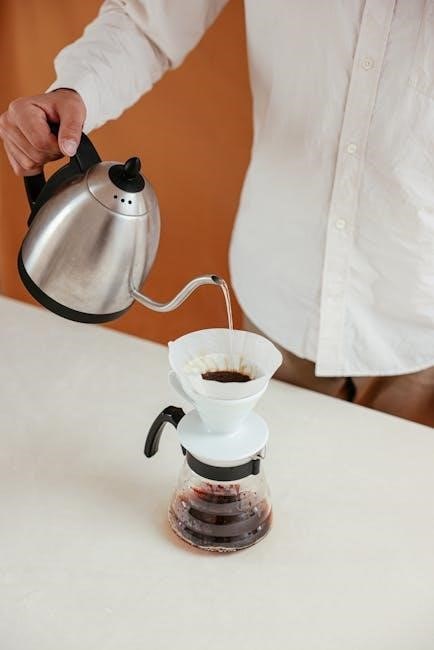Choosing the right rock climbing shoe size is critical for performance, comfort, and safety. This guide helps navigate sizing challenges, ensuring a perfect fit for every climber’s needs.
Importance of Proper Fit in Rock Climbing Shoes
A proper fit in rock climbing shoes is essential for performance, comfort, and safety. Ill-fitting shoes can lead to blisters, reduced sensitivity, and compromised control, which are critical for precise footwork. A snug fit enhances grip, stability, and confidence, allowing climbers to focus on their technique. Properly fitted shoes also prevent discomfort during long climbs, ensuring sustained performance. For beginners, a comfortable yet snug fit helps build trust in their gear, while experienced climbers rely on precise fits for advanced maneuvers. Different climbing styles and shoe types require varying fits, making it crucial to understand sizing nuances. This guide helps climbers navigate these factors to find their ideal fit, maximizing both comfort and performance.
Overview of Rock Climbing Shoe Sizing Challenges
Rock climbing shoe sizing presents unique challenges due to the lack of uniformity across brands and styles. Different manufacturers use varying sizing systems, making direct comparisons difficult. Street shoe sizes often don’t translate accurately, as climbing shoes are designed to fit snugly for performance. Additionally, materials like leather or synthetic fabrics stretch over time, affecting the initial fit. The Mondopoint system, which measures foot length and width in millimeters, offers a more precise method but isn’t universally adopted. Climbers must also consider their climbing style, foot shape, and personal comfort preferences. These factors combined create a complex landscape for finding the perfect fit, requiring careful consideration and often trial and error. Understanding these challenges is key to navigating the sizing process effectively and ensuring optimal performance and comfort on the rock.
Factors Affecting Rock Climbing Shoe Size
Climbing style, foot shape, and material stretch are key factors influencing shoe size. Each element ensures a balance between comfort and performance for optimal climbing experiences.
Climbing Style and Its Impact on Shoe Fit
A climber’s style significantly influences shoe fit. Bouldering requires snug, precise shoes for maximum sensitivity, while lead climbing may allow slightly roomier fits for comfort during longer routes. Speed climbers prioritize lightweight, tight shoes for quick movements. In contrast, all-day climbers might opt for a more comfortable fit to prevent fatigue. Competitive climbers often choose aggressive, tight shoes for performance, even if less comfortable. Each style demands a specific balance between snugness and mobility, making it essential to match shoe fit to climbing goals and preferences. Proper fit enhances performance, safety, and overall climbing enjoyment.
Foot Shape and Volume Considerations
Foot shape and volume play a crucial role in selecting climbing shoes. Climbers with narrow or low-volume feet may prefer slimmer shoes for a snug fit, while those with wider or high-volume feet need roomier models to avoid discomfort. Brands often cater to different foot shapes with various last designs, offering options for both men and women. For example, Scarpa uses over 20 different lasts, ensuring a tailored fit. It’s essential to consider both length and width when choosing a shoe, as improper fit can lead to performance issues or discomfort. Measuring foot dimensions accurately and consulting brand-specific sizing charts can help climbers find the ideal match for their unique foot shape and volume.
Stretching of Materials Over Time
Climbing shoe materials can stretch significantly over time, affecting fit and performance. Leather shoes, like many La Sportiva models, can stretch up to two full sizes, requiring a snug initial fit to avoid becoming too loose. Synthetic or vegan materials, found in brands like Evolv, stretch less, typically around half a size, and feel more consistent from the start. This variation means climbers must consider material type when sizing. Beginners may prefer less stretch for comfort, while experienced climbers might opt for leather shoes that mold to their feet over time. Understanding how materials behave ensures a better fit and climbing experience, as shoes will naturally loosen with use. Proper sizing accounts for this stretch to maintain optimal performance and comfort.

Understanding Climbing Shoe Sizing Systems
Mondopoint is a universal sizing system measuring foot length and width in millimeters. It helps compare sizes across brands. Converting street shoe sizes to climbing shoes varies by brand, as each may have unique fits. This system ensures accuracy and consistency, making it easier to find the right size for your climbing shoes.
Mondopoint Sizing System Explained
The Mondopoint system is a precise method for measuring foot length and width in millimeters, creating a universal standard for shoe sizing. It was originally designed for ski boots but is now widely used in climbing footwear. By eliminating the ambiguity of traditional sizing, Mondopoint ensures consistency across brands. To determine your Mondopoint size, measure the longest foot’s length and width. This system allows climbers to accurately match their foot dimensions to a shoe’s specifications. Brands provide Mondopoint charts, enabling climbers to select the ideal size based on exact measurements. This approach minimizes guesswork and helps avoid common fitting issues, ensuring a more comfortable and effective climbing experience.
Converting Street Shoe Size to Climbing Shoe Size
Converting street shoe size to climbing shoe size requires careful consideration, as climbing shoes often fit differently. Climbers typically size down for better performance, but the exact conversion varies by brand and style. While some may opt for a snug fit similar to their street shoe size, others prefer a tighter fit for precision. Beginners often choose sizes closer to their street shoe size for comfort, while experienced climbers might size down significantly. It’s important to try shoes on and consider factors like climbing style and foot shape. Always refer to brand-specific sizing charts and guides to ensure the best fit for your needs. This approach helps avoid common sizing mistakes and enhances overall climbing performance.
Brand-Specific Sizing Variations
Brand-specific sizing variations play a significant role in selecting the right climbing shoes. Different brands use unique lasts and materials, leading to diverse fits. For example, La Sportiva and Evolv may have the same numerical size but fit differently due to their distinct shoe designs. It’s crucial to consult each brand’s sizing chart and consider factors like foot shape and climbing style. Some brands cater to narrower feet, while others accommodate wider or higher-volume feet. Understanding these variations ensures a more precise fit, enhancing comfort and performance. Always try shoes on if possible and reference brand-specific guides to make informed decisions tailored to your needs. This approach helps in navigating the complexities of sizing across different manufacturers.
How to Measure Your Foot for Climbing Shoes
Measure your foot length using a ruler and paper, then reference the mondopoint system for precise sizing. Fit varies by material stretch and climbing style; use brand-specific charts and try shoes on if possible.
Step-by-Step Guide to Measuring Foot Length
To accurately measure your foot length for climbing shoes, start by placing a sheet of paper on a flat surface. Stand barefoot on the paper, ensuring your weight is evenly distributed. Trace the outline of your foot with a pencil, holding it perpendicular to the paper. Measure the longest point of your foot (heel to big toe) using a ruler. Repeat for both feet, as one foot may be larger than the other. Use the mondopoint system, which measures foot length in millimeters, to find your size. Compare your measurement to climbing shoe size charts for an accurate fit. Consider foot width and shape when selecting a shoe, as these factors also impact comfort and performance.
Accounting for Foot Width and Volume
Foot width and volume significantly influence the fit of climbing shoes. Measure foot width by tracing the widest part of your foot on paper. Compare this to brand-specific sizing charts, as some brands cater to narrower or wider feet. Foot volume refers to the overall girth, including the arch and instep. Climbers with higher volume feet may need a roomier toe box, while those with lower volume may prefer a snug fit. Brands like Scarpa offer multiple last shapes to accommodate different foot widths. Don’t overlook these factors, as they ensure optimal comfort and performance. Properly accounting for width and volume helps prevent discomfort and ensures a secure fit during climbs. This step is crucial for both beginner and experienced climbers to maximize their shoe’s potential.
Using Sizing Charts Effectively
Utilizing sizing charts is essential for finding the perfect fit in climbing shoes. Start by measuring your foot length and width accurately, then compare these measurements to the chart. Mondopoint sizing, which measures foot length in millimeters, is a universal standard many brands use. When using a chart, consider your street shoe size as a reference, but remember that climbing shoe sizing often differs. Pay attention to brand-specific variations, as some brands run larger or smaller; If unsure, try on shoes in person or refer to user reviews for fit insights. Finally, account for material stretch; leather shoes stretch more than synthetic ones, so size accordingly for the best performance and comfort.
Types of Rock Climbing Shoes and Sizing

Rock climbing shoes come in three main types: beginner, intermediate, and performance. Each type offers a different fit, with sizing varying to balance comfort and precision.
Beginner Climbing Shoes: Fit and Size Recommendations
For beginners, finding the right fit is crucial to ensure comfort and confidence; Sizing down from street shoes is common, but avoid extreme tightness. A snug fit with minor toe curl is ideal, allowing for comfort during longer climbs. Beginner shoes should feel tight but not painful, as they will stretch over time. Leather shoes, popular for their durability, can stretch up to two sizes, so starting with a slightly tighter fit is recommended. For those prioritizing comfort, sticking close to street shoe size is a safe choice. However, sizing too comfortably can lead to shoes feeling too loose after the break-in period. Always consider foot shape and volume when selecting a model, as different brands cater to varying foot types. Proper fit ensures better performance and prevents discomfort during initial climbing experiences.
Intermediate Climbing Shoes: Balancing Comfort and Performance
Intermediate climbers often seek shoes that balance comfort and performance. These shoes offer moderate toe curl and snug fits without the extreme tightness of performance models. Sizing may require a half to one size down from beginner shoes to achieve optimal fit. Leather shoes remain popular but may need breaking in, while synthetic materials offer less stretch. Climbers should expect a tighter fit compared to their first pair, but not so tight it causes discomfort. Proper sizing ensures better precision on holds while maintaining enough comfort for longer sessions. Trying shoes on and testing their feel during climbing movements is crucial for intermediate climbers looking to enhance their skills without sacrificing comfort.
Performance Climbing Shoes: Aggressive Fit and Sizing
Performance climbing shoes are designed for expert climbers seeking maximum precision and power. These shoes feature an aggressive fit, with a snug, tight design that prioritizes performance over comfort. Sizing is critical, as they are meant to hug the foot tightly, often requiring climbers to size down significantly. Leather models, in particular, may require breaking in and can stretch up to two sizes over time. Synthetic materials offer less stretch but still demand a precise fit. These shoes are not recommended for beginners, as they can be painful initially. For experienced climbers, the aggressive toe curl and tight fit enhance edging and accuracy on difficult routes. Proper sizing ensures optimal power transfer and control, making them a worthwhile investment for serious climbers aiming to push their limits.

Manufacturer-Specific Sizing Guides
Each brand offers unique sizing systems, so consulting their specific guides is essential. Variability exists between brands, and climbers must refer to individual charts for accurate fit determination.
La Sportiva Sizing Chart and Fit Tips
La Sportiva offers a detailed sizing chart to help climbers find their perfect fit. The brand recommends sizing down from street shoe size for a snug performance fit. For example, if you’re a 38.5 EU in street shoes, consider a 36.5 in La Sportiva climbing shoes. Their beginner shoes should have a minor toe curl, while intermediate and performance models require a moderate to aggressive toe curl. La Sportiva’s leather shoes can stretch up to two sizes, so buying tight is advisable. Using their mondopoint measurements ensures accuracy, especially for wider or thicker feet, which may need a larger size.
Scarpa Sizing Chart and Foot Shape Considerations
Scarpa offers a comprehensive sizing chart tailored to various foot shapes and volumes. With over 20 last shapes, including 9 dedicated to women, Scarpa ensures a custom fit for different foot types. The brand emphasizes the mondopoint system, measuring foot length and width for accuracy. Climbers with wider or thicker feet may need to size up for comfort. Scarpa’s sizing chart accounts for material stretch, especially in leather shoes, which can stretch up to a full size during the break-in period. This ensures a snug, performance-oriented fit over time. By considering both foot shape and material properties, Scarpa provides a personalized fit for climbers of all levels.
Evolv Sizing Chart and Material Stretch Factors
Evolv’s sizing chart is designed to cater to diverse foot shapes and climbing styles. The brand uses a combination of synthetic and leather materials, each with unique stretch properties. Synthetic materials, like those in vegan-friendly models, offer minimal stretch (around 0.5 sizes), providing a snug fit from the start. Leather models, while more comfortable post-break-in, can stretch up to 1.5 sizes. Evolv recommends sizing based on street shoe size for a comfortable fit, but climbers seeking performance may opt for a half-size down. The brand’s sizing system aligns closely with standard shoe sizes, making it easier for climbers to find their ideal fit. Material choice plays a crucial role in long-term comfort and performance, ensuring Evolv shoes adapt to individual foot shapes over time.

How to Choose the Right Size for Your Needs
Selecting the right climbing shoe size involves balancing comfort, performance, and climbing style. It’s essential to consider personal experience level, shoe materials, and brand-specific sizing to ensure an optimal fit.
First-Time Buyers: How to Avoid Common Mistakes
First-time buyers often make mistakes when sizing climbing shoes. A common error is relying solely on street shoe size, which can lead to poor fit due to brand-specific sizing variations. Many newcomers also overlook the importance of considering foot shape and volume, assuming a “one-size-fits-all” approach. Additionally, some buyers might not account for material stretch, especially in leather shoes, which can loosen significantly over time. To avoid these pitfalls, it’s crucial to try shoes on, consider the climbing style, and refer to brand-specific sizing charts. Remember, climbing shoes should feel snug but not painful, ensuring both comfort and performance. Proper fit is key to enhancing your climbing experience and preventing discomfort during use.
Understanding the Break-In Period for New Shoes
Understanding the break-in period is essential for climbers, especially with new shoes. Leather climbing shoes, for instance, can stretch up to two full sizes over time, while vegan shoes made from synthetic materials stretch less, typically around half a size. This natural loosening means climbers should initially opt for a snug fit to avoid shoes becoming too roomy. For performance shoes, the break-in period can be more intense, sometimes requiring careful stretching or even using tools like plastic bags to ease the fit. It’s crucial to consider the material and intended use when sizing, as the break-in process varies significantly. Trying shoes on after the break-in period, if possible, ensures a more accurate fit. This knowledge helps climbers avoid discomfort and ensures optimal performance during their climbs.
When to Size Down or Up Based on Experience Level

Your experience level plays a significant role in determining whether to size down or up for rock climbing shoes. Beginners should opt for a more comfortable fit, often sizing up slightly to avoid discomfort during initial climbs. Intermediate climbers may prefer a moderate fit, balancing performance and comfort, which might mean sizing down by half a size. Advanced climbers, particularly those focused on performance, often size down aggressively to achieve a snug, precise fit, enhancing control on challenging routes; It’s important to note that sizing preferences evolve with experience, and what works for one level may not suit another. Listening to your body and adjusting based on performance needs ensures the best fit for your climbing journey.

Care and Maintenance of Climbing Shoes
Proper care and maintenance of climbing shoes ensures longevity and performance. Regularly clean shoes with mild soap and water, and allow them to air dry to prevent odor and damage. Replace shoes when soles wear thin or fit becomes loose due to stretching over time.
How to Stretch or Shrink Climbing Shoes
Stretching or shrinking climbing shoes can be necessary due to material expansion or fit adjustments; Leather shoes can stretch up to two sizes over time, while synthetic materials stretch less. To stretch, wear shoes with thick socks or use a plastic bag during initial sessions. For shrinking, apply heat carefully or consider a smaller size next time. Regular cleaning and proper storage help maintain shape and performance, preventing excessive stretching. Understanding these methods ensures optimal fit and longevity of your climbing shoes.
Cleaning and Preserving Your Climbing Shoes
To maintain your climbing shoes, clean them regularly using a mild soap and water. Gently scrub the exterior with a soft brush, avoiding harsh chemicals that could damage materials. Rinse thoroughly and allow the shoes to air dry away from direct heat. For odors, sprinkle baking soda inside and let it sit overnight before shaking it out. Avoid machine washing or using heat, as this can deform the rubber or synthetic materials. Conditioning leather shoes occasionally can help preserve their flexibility and longevity. Regular cleaning not only enhances performance but also prevents bacteria buildup, ensuring your shoes remain fresh and functional for future climbs.
When to Replace Your Climbing Shoes
Replacing your climbing shoes is essential when they show significant wear. Look for signs like thinned soles, split seams, or excessive stretching. If the rubber on the toe or heel is worn down, it can compromise grip and performance. Additionally, if the shoes no longer hold their shape or feel loose, it’s time for a new pair. For most climbers, shoes need replacing every 6 to 12 months, depending on usage. Performance shoes may require more frequent replacement due to aggressive wear. Ignoring these signs can lead to reduced climbing efficiency and potential safety risks. Always prioritize footwear condition to maintain optimal climbing performance and comfort.
Finding the perfect fit in rock climbing shoes is essential for optimal performance and comfort. The right size enhances your climbing experience and confidence.
Final Tips for Finding the Perfect Fit
When searching for the ideal rock climbing shoe fit, prioritize your climbing style and foot shape. Use the Mondopoint system to measure foot length and width accurately. Avoid sizing based solely on street shoe size, as climbing shoe brands vary significantly. Always try shoes in person if possible, and consider the stretch potential of materials. For beginners, opt for a snug but comfortable fit, while experienced climbers may prefer tighter shoes for performance. Don’t hesitate to seek advice from experienced climbers or gear shop staff. Finally, remember that the break-in period can make a big difference in comfort and fit. By combining these strategies, you’ll find a pair that enhances your climbing experience.
Importance of Comfort and Performance in Rock Climbing
Comfort and performance are key to a successful rock climbing experience. Ill-fitting shoes can cause discomfort, impairing focus and technique. Properly fitted shoes ensure precision, control, and confidence. They allow climbers to maintain optimal foot placement and power, crucial for challenging routes. Comfort prevents distractions from pain or blisters, enabling climbers to concentrate on their ascent. Performance-oriented shoes offer features like snug fits and aggressive toe curls, enhancing sensitivity and grip. Balancing these factors ensures climbers can perform at their best, whether tackling easy routes or advanced ascents. A perfect fit is essential for maximizing both comfort and performance, making it a cornerstone of effective rock climbing.


























































